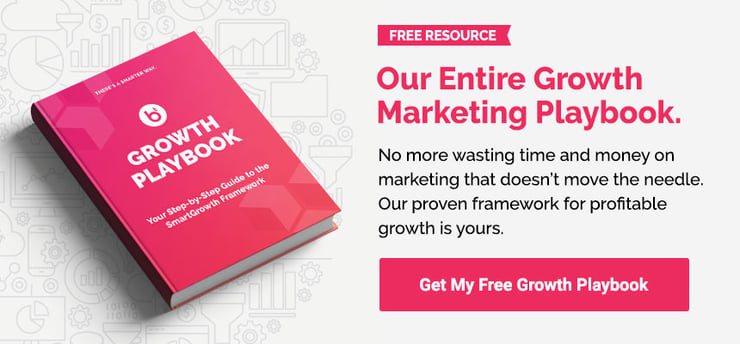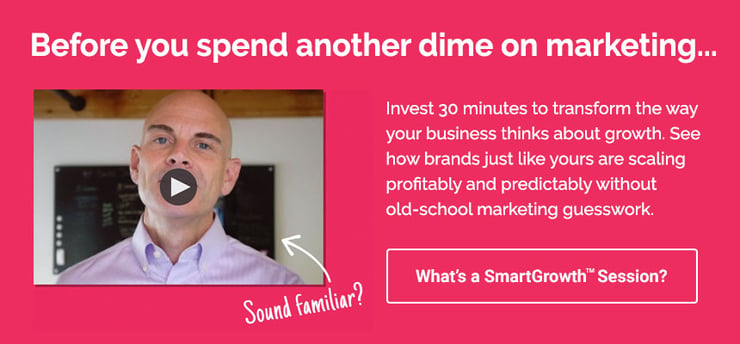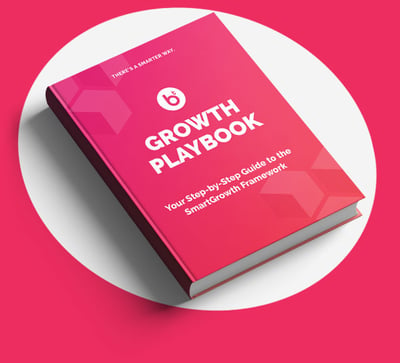Among the many marketing strategies, frameworks, and tactics out there, growth marketing gets a lot of buzz. But what is growth marketing? Is it really any different from other marketing strategies or is it just the same old tactics packaged with a fancy new name?
Growth marketing is not the same as digital marketing, demand marketing, or even growth hacking. Yep, growth marketing is different all right. Find out exactly how it’s different and the difference it can make for your business in this 5-minute growth marketing crash course.
Part 1: What is growth marketing and growth marketing strategy?
Growth marketing is a full-funnel approach to marketing that helps businesses scale profitable customer acquisition by continuously measuring, testing, and improving at every stage.
Growth marketing strategies begin with data—your data—to guide each step in filling your pipeline, and generating leads, customers and revenue. Using popular marketing tactics or channels "just because" isn't part of a growth marketing strategy. Hoping you’ll attract customers has no place in a growth marketing strategy. Instead, every marketing campaign, tactic and action you execute is done for a reason. And, you don’t invest at scale in any marketing activity until your data tells you it’s a winner.
Growth marketing is smart marketing. It empowers your business to grow profitably and predictably by always focusing your marketing resources on the right stages of your customer acquisition pipeline—where they will create the biggest impact.
What does it mean to have a full-funnel marketing strategy?
If you've been looking into ways to increase your revenue or improve your marketing efforts, you’ve probably heard about marketing or sales funnels or customer acquisition pipelines. These are just names used to describe the steps or stages someone goes through to become your customer (a.k.a. “the buyer journey”).
Some marketing strategies focus on a 3-stage journey that includes awareness, consideration and conversion. A buyer learns about your brand, they consider your products or services, and, at the final stage, they make a purchase decision.
Much of marketing’s role in this process is to educate buyers about the problems or challenges they are trying to solve, through content that will ultimately guide them to your website and into your marketing and sales funnel. That’s lead generation—and it’s important. But, it isn’t enough to achieve sustainable, profitable growth.
Growth comes when you convert more leads into customers and more of your customers into repeat customers and advocates for your business. And when you do it all in a systematic, repeatable way.
A successful growth marketing strategy identifies opportunities across the buyer journey, beyond a single sale. Your growth marketing strategy should include the following stages:
- Awareness: Attracting potential buyers with engaging content
- Acquisition: Generating leads from your target audience
- Activation: Entering qualified leads into your sales process
- Revenue: Completing a successful sale
- Retention: Expanding revenue with existing customers (upsell, re-sell, cross-sell)
- Referral: Generating revenue through word-of-mouth referrals and reputation
The first three stages of this funnel take a prospect from no knowledge about your business to being a sales qualified lead (SQL)—someone who has a problem your product or service can solve, is aware that you offer a solution and is considering purchasing from you. In the final three stages of the growth marketing pipeline, your lead becomes not only a loyal customer, but also a source of new leads.
This renewable cycle is the secret to continuous growth and predictable revenue. Marketing dollars spent on retaining existing customers and converting them to brand advocates amplifies the results of every customer acquisition, increasing their lifetime value (LTV) and reducing your customer acquisition cost (CAC).
More revenue with less cost. That sounds great, right? But how does a growth marketing strategy make that happen? That’s up next.
Part 2: How to implement a growth marketing strategy
The thing about a growth marketing strategy is that it is strategic. Before you market to buyers at any stage of your funnel, you need to define your brand's marketing objectives. And, before you use a tactic to achieve each goal you’ve identified, you need to understand why. Only then are you ready to build your marketing assets and execute your strategy. In other words, first you plan, then you build, then you scale.
Plan
The planning stage is critical for effective growth marketing. This is the stage where you’ll gather and evaluate data about your current situation.
- How is your business performing?
- What are the present economic and market challenges?
- How big are the competitive threats your business faces?
After looking at your business’s historical performance and current situation. Goal-setting is the next step in the planning stage. This is where you define where you want your business’s performance to be and evaluate what you’ll need to achieve on a per unit and per quarter basis to reach that level.
- Do you want to increase your number of leads by 20% next quarter?
- What are your revenue goals for the next one, three, and five years?
- How much will you aim to reduce customer churn this year?
Along with setting goals, you’ll also define your marketing message and positioning during the planning stage. A solid unique value proposition is essential—along with aligning your team on how you’ll convey that to buyers—before you begin building your marketing assets.
Finally, you’ll begin to identify the specific marketing tactics that you’ll use to achieve each of your goals.
Build
Once you know what you want to achieve and how you plan to achieve it, you are ready to create the marketing assets necessary to support your plan. You’ll develop your website, lead magnets, and other marketing vehicles.
By relying on your strategic framework and staying true to your goals and positioning, you can create assets that always convey the right message to the right buyer at the right time—with the right next step. Engaging buyers and moving them forward in your pipeline is the purpose behind every asset in your marketing arsenal.
Of course, it’s not possible to predict every outcome. As your website and other marketing assets are launched, you’ll begin collecting data. Is your content performing as expected? Are your lead generation efforts paying off? If not, this is the time to begin testing and improving. Your growth marketing strategy should never be static. Instead, it should serve as a strong, yet responsive foundation that thrives on continuous improvement.
Scale
This is where the magic happens. With a tried and tested, customer-focused strategy in place, you are ready to scale. You now have the blueprint for phenomenal growth. Leverage and expand successful tactics, invest in your proven marketing activities and build upon each successive win.
The wrap up: You don’t have to go it alone when executing a growth marketing strategy
Now that you’ve finished this crash course in growth marketing, you may be wondering how you’ll manage all of this while running your business. The good news is, you don’t have to. In fact, you probably shouldn’t. I mean, how much time do you really have to learn about SQLs, marketing tactics and sales funnels? Working with an experienced team of growth marketers, you can get the benefits of deploying a growth marketing strategy without guesswork.
Brand Theory works with businesses like yours every day, helping them to find their unique position in the market and follow a clear path to results with a proven growth marketing system.
Of course, you’ll still need to be involved in the process—no one knows your business better than you. However, you’ll have a team to focus on growing your business while you focus on running it. Curious to see exactly how growth marketing can help? Schedule your no-pressure SmartGrowth Session today and get a free plan tailored to your growth goals.






.png)
.png)
.png)
